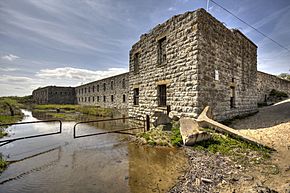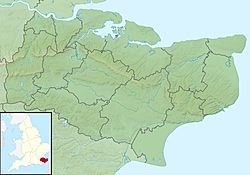Cliffe Fort facts for kids
Quick facts for kids Cliffe Fort |
|
|---|---|
| close to Cliffe-at-Hoo, Kent | |

View of the south-east corner bastion of Cliffe Fort
|
|
| Coordinates | 51°27′49″N 0°27′21″E / 51.463608°N 0.455871°E |
| Type | Fortification |
| Site information | |
| Owner | Brett Aggregates |
| Open to the public |
No |
| Condition | Derelict |
| Site history | |
| Built | ca. 1861–70 |
| Built by | United Kingdom |
| In use | 1870–1950s |
| Materials | Concrete, granite |
| Battles/wars | First World War, Second World War |
Cliffe Fort is an old artillery fort built in the 1860s. Its job was to protect the entrance to the River Thames from attacks by ships. The fort stands on the south side of the river. It is located in the Cliffe marshes on the Hoo Peninsula in North Kent.
Building the fort on marshy ground caused many problems. The ground was soft, and the fort started to crack and sink during construction. This meant the original plans had to be changed. Cliffe Fort was armed with large guns. These guns were meant to work with two other forts nearby on the Thames. Later, a special launcher for the Brennan torpedo was added. This torpedo has been called the world's first practical guided missile!
Cliffe Fort was used as an artillery fort for about 60 years. It was finished in 1870 and its guns were removed in 1927. During World War II, it was used as an anti-aircraft battery. This helped protect London from air attacks. After the war, the fort was sold. Today, it is abandoned, overgrown, and often flooded. You cannot visit it, and it is slowly falling apart. Because of its poor state, it is listed as an "at risk" historical site.
Contents
Why Cliffe Fort Was Built
In the late 1850s, Britain and France were in an "arms race." This means they were both trying to build more powerful weapons than the other. New, very accurate guns were invented. Also, fast, steam-powered warships made of iron, like the French La Gloire and the British HMS Warrior, were being built.
These new warships were a big threat to important naval bases on the Thames. These bases included places where food was stored for the navy in Deptford. There were also weapons factories at Woolwich Arsenal and shipbuilding yards at North Woolwich. Even though large warships could not reach central London, they could still sail past forts and attack places up coastal rivers.
Britain's coastal defenses had not been updated much since the Napoleonic Wars. Some older forts were in the area around Tilbury and Gravesend. But these forts were old and not very useful anymore. So, the government set up a group called the Royal Commission on the Defence of the United Kingdom. In 1860, they suggested building a triangle of new forts on the lower Thames, east of Gravesend.
This plan involved building a new Coalhouse Fort on the Essex side of the river. They would also replace the old Shornemead Fort. And a brand new fort would be built at Cliffe. This new fort would replace an even older battery at Lower Hope Point. The idea was that the guns from these three forts could fire together, creating a strong defense.
Building the Fort
Cliffe Fort was built between 1861 and 1870. It cost about £163,000, which was a huge amount of money back then. Captain Siborne of the Royal Engineers designed the fort. Captain English and Lieutenant English, also from the Royal Engineers, designed the strong iron and steel shields for the gun positions.
The first plan for the fort was quite different. It was supposed to have 13 guns on its roof, called the terreplein. Three more guns would be in an open area, and two guns would be for defending the land. Below, there would be 20 guns inside strong rooms called casemates. These casemates had granite fronts and iron shields. The fort was also planned to have a main magazine for ammunition. It would also have rooms for filling shells and smaller magazines. The entire fort was supposed to sit on a concrete base 7 ft (2.1 m) thick.
However, building on marshy land next to the river caused many problems. The ground was very soft. The depth of the foundations had to be made much deeper. They used a concrete base 14 ft (4.3 m) thick, supported by wooden piles 30 ft (9.1 m) long. In 1865, the fort started to sink and crack even while it was being built. Because of this, they had to give up on the idea of putting guns on the roof.
Instead, the fort was redesigned to have only casemated guns, similar to Coalhouse Fort across the river. A moat (a ditch filled with water) and earthworks were added to protect the fort from the river side. The conditions for the workers building the fort were very bad. The area was waterlogged, and workers often got sick with malaria and bronchitis. An officer described the living quarters as "an abominable stinking place in summer, very cold and wet in winter."
How the Fort Was Used
By 1887, Cliffe Fort had many powerful guns. It had two 12.5-inch and nine 11-inch RML (Rifled Muzzle Loader) guns inside its casemates. It also had two 9-inch RML guns in an open area. These guns were placed so their firing range would overlap with the guns at Coalhouse and Shornemead Forts. This created a strong defense. Later, special positions were added to the roof for optical range-finders. These helped measure distances to enemy ships.
After 1887, something very interesting was added to the fort: a launching station for the Brennan torpedo. This weapon is known as "the world's first practical guided missile." One of the fort's magazines was changed into a room for the torpedo's engine and other machines. One of the open gun positions also had to be removed to make space.
A large concrete room was built at the front of the fort to store the torpedoes. They were launched from a rail on the roof of this torpedo room. Walls were added to the roof to protect the people launching the torpedoes from enemy fire. Two slipways were built at different times for launching. Only one of these slipways still exists today. A special telescopic control tower was also added to the roof to help guide the torpedoes.
After 1895, the fort was updated again. Concrete positions were added to the roof for new quick-firing (QF) guns. First, three 3-pounder QF guns were added. Later, these were replaced by four 12-pounder QF guns. These new guns were meant to protect a planned boom defense and minefield. These defenses would stop enemy ships from getting through. Searchlights were also installed, and the fort's ditch was mostly filled in.
During World War I, the 12-pounder guns were replaced by two 6-inch guns. These were placed on the fort's roof. Near the end of the war, these were replaced by four QF guns. The torpedo station was taken apart by this time. Cliffe Fort's guns were removed in 1927. But during World War II, two of the positions on the roof were changed. They were used for two 4-inch anti-aircraft guns. The fort was also used as a base for the Royal Navy Auxiliary Service during the war.
Current Status
The War Office sold Cliffe Fort in the 1950s or 1960s. It was bought by the company that owns the large aggregates (like sand and gravel) works next to the fort. It used to be owned by Blue Circle Aggregates, but now it belongs to Brett Aggregates. They operate a wharf nearby where they process materials dug from the sea.
For a while, the fort was used as the headquarters for the Blue Circle Sailing Club. But eventually, it was abandoned and left to fall apart. It is not open to the public, and fences block access. However, you can see the outside of the fort from the Saxon Shore Way coastal path.
Today, Cliffe Fort is abandoned and in very poor condition. The inside of the fort is heavily flooded and has been damaged by vandals. The living quarters have fallen into ruin. The outside is overgrown with plants and partly flooded. Piles of sand from the nearby aggregates works surround it. Even though it is structurally sound, the fort is listed on the English Heritage "Heritage at Risk" register. This means it is a historical site that needs urgent care to prevent it from being lost.
Images for kids















